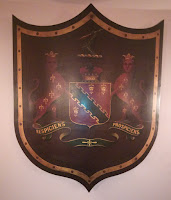At the weekend I attended my daughter's post-nuptial shindig (the nuptials themselves having taken place a year ago at Reading Town Hall, with a cast of 6 including the bride and groom) at a quirkily decorated pub. May she and her Unworthy Swain (a title I originally coined for my little sister's husband, but now pass down to my son-in-law – "something borrowed", perhaps – have a long and fruitful life together.
And now, the coincidence. First, a bit of background: early in the twentieth century (if not earlier – Wikipedia says ...
As London developed, the area became predominantly market gardens which required a greater proportion of workers as it was more labour-intensive. In the 1850s, with improved travel (the Great Western Railway and two branches of the Grand Union Canal), villages began to grow into towns and merged into unbroken residential areas. At this time Ealing began to be called the "Queen of the Suburbs".
...) the name Queen of the Suburbs became current, and Nikolaus Pevsner repeated this accolade in his 1951 Middlesex volume in his "The buildings of England" series – coinciding with the year of my birth...
<inline_ps>....I can't pretend that this gave me a predilection for the sobriquet, as I only noticed this coincidence today, but I have long been known to use the expression when referring to my native...
(and also, as it happens with the inauguration of my choir, which is celebrating its 70th anniversary in the current season)
</inline_ps>
<autobiographical_note>
(not quite native; we moved there in 1953, for reasons explained here. My little sister was a native, and it was the family home for about twenty years.)
</autobiographical_note>
...town. In fact, at a college reunion party I was once greeted as "Knowles, King of the Queen of the Suburbs".
 |
| Ealing's 1902 coat of arms |
(Stay with me; there's a point to all this, honest.)
In the mid-sixties, however, the burghers of Ealing had to get rid of the Middlesex reference (the three swords), and (no doubt at some expense, silly burghers) they changed the motto as well – getting rid of that so-last-year Latin stuff ...
<parenthesis type="supposed design comments">...but kept the pro- of prospice ["Look forward"]: "Progress with Unity"; pretty inspiring, don't you think.
(Respice? ["Look back"] Where's that at? Besides, doesn't it suggest "Load up again with turmeric"?)
<parenthesis>
 |
| Home-lit (ie not lit) photo of the shield |
At last, the point:
On the wall of the main reception room there was this coat of arms (with the motto Respiciens Prospiciens – the same two verbs ("Look back" and "Look forward"), but in the present participle (or "ing- form" as I learnt to call it during my CELTA training) rather than the imperative. I wondered if there could be a link between Ealing and the original owners of these arms, whoever they may have been
Farringford is a Grade 1 Listed Building and was the main residence of the Poet Laureate Alfred, Lord Tennyson from 1853 until his death in 1892. It continued in the possession of the Tennyson family until 1945, when it was sold to British Holiday Estates Ltd, who converted the house into a hotel.
SourceHere's where The Bell (est. 2011) comes in. That Farringford House history continues:
Farringford remained a hotel until 2010, when work began to restore the building to its original condition as a historic home.
It's a fairly safe bet that the newly-refurbishing pub took advantage of the sale (including the shield, mentioned in the 2008 ARCHITECTURAL AUDIT (INTERNAL)):
In the west wall, there is a fireplace with ornate wooden surround [80]. A wide, built-up moulded mantle-piece is supported by five main corbels containing human and lion faces in relief above a moulded leaf. ... The cast iron fireplace has two tall, thin decorated side panels, while along the top are seven quatrefoils containing a rosette motif except for the centre one, which holds a shield with Tennyson’s embossed initials, ALT.
The photo I took wasn't well enough lit for a really meticulous/pathological? search for these initials, though in the interests of academic rigour it seems to me that such a search is worth doing (in an arguable sense of worth).
Enough standing and staring though; there are leaves to be swept up.
b
Update 201211104.11:20 – Added <inline_ps />
No comments:
Post a Comment